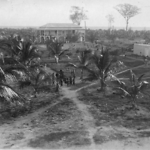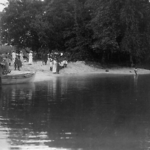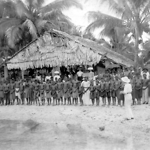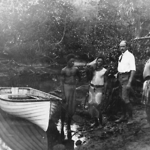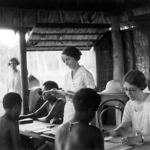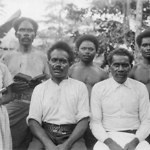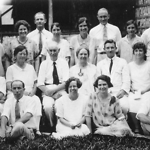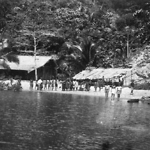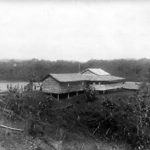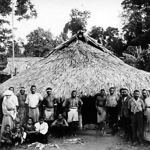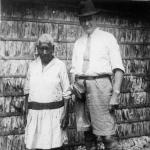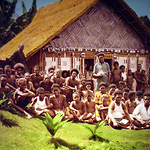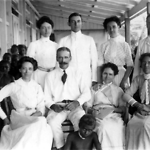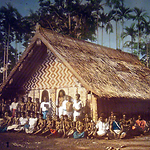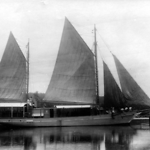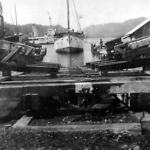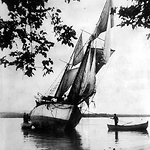Corporate entry: South Sea Evangelical Church
- Functions
- Religion
Details
The South Sea Evangelical Church is an evangelical Pentecostal Christian Church in the Solomon Islands and Papua New Guinea. It is the third-largest church in the Solomon Islands today and is strongest on Malaita. Florence Young (q.v.) founded it as the Queensland Kanaka Mission (QKM) (q.v.) in Bundaberg, Queensland in 1886, and changed its name to the South Sea Evangelical Mission in 1907. Young was figuratively heir to Puritan and Baptist traditions and steeped in the beliefs of the Open Brethren. Her influences included the Keswick Convention and the wider evangelical movement. She was knowledgeable about Christian missions in Africa and Asia, and built a successful chain of mission bases throughout coastal Queensland and northern New South Wales.
The QKM's first Solomons branches were on Malaita and in 1905 the mission established its headquarters at Onepusu in west 'Are'are. The first Solomons QKM branch was actually at Malu'u, where Peter Abu'ofa (q.v.), who had been trained by the QKM at Bundaberg, had started a mission in 1895. Its second branch was begun at Fo'ondo that same year. Several members of the Young and Deck families were involved in the early years. The SSEM quickly expanded around Malaita, then to Wanoni Bay on Makira in 1907, and the next year to Talise on the southwest coast of Guadalcanal. In 1910 it moved onto Rennell Island but then withdrew after three staff were killed, not returning until April 1934. (Griffiths 1977, 93) Although congregations received guidance from the hierarchy, one of the SSEM's strengths was that its members spread the message and opened new Bible Schools. Between 1904 and 1926 Florence Young, based in Bundaberg, Sydney and Katoomba, made lengthy annual visits to the Solomons and particularly to Malaita, which was central to QKM-SSEM plans. The Mission's main ship was the Evangel. Young died in 1940, and even thought she had ceased her annual visits to the Solomons in 1926 she continued to run the Mission from her home base in Sydney, assisted by a council. After her death, and with the disruption of the Second World War, it became clear that a new structure was needed, and the Mission became an incorporated body with a Board of Directors. (Griffiths 1977, 159-160)
There were close ties between the SSEM and the Malayta Company (q.v.) and Fairymead Sugar Company (q.v.), both largely controlled by the Young family and operated in tandem with the SSEM in the Solomons. The QKM and the SSEM used Pijin English and local languages for education but, under pressure from the Protectorate Government, began to use English in the 1920s. The SSEM was strict in regard to all psychoactive drugs, discouraging alcohol, tobacco and betel nut. While the SSEM did have some powerful backers, it always had to struggle for lack of larger support systems such as those of the major churches.
Many SSEM teachers became important leaders in the Maasina Rule movement (q.v.), and for a time most Malaitan SSEM members ostracized its white missionaries. After the Second World War, the SSEM commenced operations in the Sepik region in the Australian Territory of New Guinea. Until the 1950s, there was no general church organisation, and then in the early 1950s the Board of Directors began to discuss how to link together the three hundred village churches. Each local church appointed officers to share pastoral and business responsibilities, and clusters of churches were brought together in District Associations, each with a President, Vice-President and Secretary. There was also a general President of all of the Associations, Timothy Anilafa. In 1958, an Advisory Committee of senior missionaries and leaders was formed. The Church was localised in 1964, but it still draws funding from independent Protestant evangelical churches in Australia and New Zealand. (Whiteman, 1983, 174; Garrett 1992, 82-87; NS 31 Aug. 1968; AR 1966, 71)
There have been many breakaway movements from the SSEM and SEEC. In 1956-1957 Shem Irofa'alu, the successor of Peter Abu'ofa in north Malaita, broke away from the SSEM and formed an independent church with around two thousand members, which he named Boboa. It lasted only two or three years and closed when Irofa'alu became a Jehovah's Witness (q.v.) and led his followers away. In 1963, Irofa'alu split from the SSEC again over issues relating to bridewealth payments, but the differences were resolved in 1972.
In 1964, seventy years after the QKM arrived in the Solomon Islands, a self-governing national church-the South Sea Evangelical Church-was inaugurated, which was registered in 1966. Then, in 1973, there was another split, by two groups, one joining the Assemblies of God and the other California Baptists. In 1975 another, sizeable group threatened to break away if the SSEC continued to maintain any association with the World Council of Churches. (Maeliau 1976)
Since then, the SSEC has grown and dramatically extended its mission. The Church has continued its work in village churches conducted by Solomon Islanders and supported solely by local offerings. It conducted regular leadership and Bible training courses and sent men for advanced training at the Christian Leaders Training College in New Guinea. The Church's education programme placed emphasis on developing Bible Schools, three of which were opened in 1968, with a Pastor's College planned for 1969. The large Central Church in Honiara, built by voluntary labour and financed by the local members, was constructed during 1968 and dedicated that August. Plans were also made to start a secondary school. The SSEC's bonds with Christians overseas were strengthened when Executive Secretary Jemuel Afia, visited Singapore to attend the Asian-South Pacific Congress on Evangelism, and by a May 1968 visit by a sixteen-man team of tradesmen from New Zealand to assist the Church in practical ways. (AR 1968, 86)
Two Bible Schools were built on Malaita in 1969, at Onepusu and Afio and were ready to open in 1970. Permanent church buildings were erected at Auki and Yandina in the Russell Islands. In Honiara a new church and recreation hall were constructed at Kukum, and a larger Bible and bookstore with a reading room was opened adjoining the Central Church on Mendana Avenue. Building also started at Auki on Central Offices for the Church, which was to incorporate a Bible and bookstore. For the first time the Church sent two delegates to the annual meeting of the Evangelical Alliance of the South Pacific at the Christian Leaders' Training College in Banz, New Guinea. The first SSEC graduates of this college returned to the Solomons after completing a four-year course, and six new students, including two women, were chosen to commence training at the college in 1970. The women graduated at the end of 1971: one remained in New Guinea as a staff lecturer while the other joined the staff of the Afio Girls' Bible Institute on Malaita. (AR 1969, 83, AR 1971, 100-101)
1970 also brought a good deal of change as the SSEM networked with other evangelical groups. A highlight for the year was a visit by a Maori Evangelist Muri Thompson, and two Church representatives, Arnon 'Atoomea and Festus Fama'ae, visited New Zealand and Australia for six months to observe activities in similar churches and to speak on behalf of the SSEC in the Solomons. Jezreel Filoa and his wife left for New Guinea for a further term as overseas missionaries. A Trade Course was commenced at Onepusu on Malaita, where Standard VII school leavers learned boatbuilding, mechanics, carpentry and house-building. (AR 1970, 91)
As with all of the Christian churches, the SSEC was becoming ever more localised. The important position of Pastor of the Honiara Church was taken up by Arnon 'Atoomea and the post of Education Secretary was filled by Ariel Famaea. Justus Ganifiri was elected President of the Church at the bi-annual conference. The Church's plan for more training in local church leadership was advanced when two Solomon Islanders were accepted for training in the New Zealand Bible College. Enrolments in the two local Bible Schools continued to rise and during 1971 extra staff were posted to the Tsuva Bible School on Guadalcanal.
During 1972, the policy of localisation continued with adoption of a five-year development plan to further equip the Church for complete self-reliance. The plan contained a scheme that provided more training for Church leaders. Six Solomon Islanders attended a graduate course in New Guinea and Sydney in June 1973. (AR 1972, 107) In 1973, Justus Ganifiri was appointed General Superintendent, and Jezreel Filoa, who had been a missionary for thirteen years in Papua New Guinea, was appointed Associate Superintendant. Two young women trained at Banz in New Guinea took over the Afio Bible Institute in South Malaita. A Bible College building was erected at Onepusu on Malaita. Arnon 'Atoomea became General Secretary of the Church and Silas Erekali an Associate Secretary after four years training at Banz. The operation of the Bible and bookstore in Honiara was taken over by David Maefasia Afia, and Solomon Islanders ran all of the Church's Bible Schools, assisted by missionary advisors. (AR 1973, 112)
During 1975, the Bible College at Onepusu was expanded, taking on nineteen students. Justus Ganifiri was General Superintendent and Jezreel Filoa was his Associate Superintendent. (AR 1974, 118) After independence the SSEC continued to grow. In 1995, the SSEC was the country's third-largest denomination, with fifty-five thousand registered adherents, over four hundred local churches and twenty-four Associations (circuits). Today the SSEC still operates by faith; it has no business or financial arms to support its ministries. All income arrives through offerings. (Griffiths 1977)
Related entries
Published resources
Books
- Garrett, John, Footsteps in the Sea: Christianity in Oceania to World War II, Institute of Pacific Studies, University of the South Pacific, in association with the World Council of Churches, Suva and Geneva, 1992. Details
- Griffiths, Alison, Fire in the Islands: The Acts of the Holy Spirit in the Solomons, Harold Shaw Publishers, Wheaton, Ill., 1977. Details
Journals
- British Solomon Islands Protectorate (ed.), British Solomon Islands Protectorate News Sheet (NS), 1955-1975. Details
Manuscripts
- Maeliau, Michael, The Remnant Church: A Separatist Church (Long Essay written at Christian Leaders Training College), Banz (Papua New Guinea), 1976. Details
Reports
- British Solomon Islands Protectorate, British Solomon Islands Protectorate Annual Reports (AR), 1896-1973. Details
Images
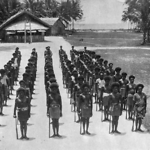
- Title
- Military-like formation of male students at Onepusu SSEM headquarters, Malaita Island
- Type
- Image
- Source
- Deck
.png)
- Title
- SSEM Onepusu Girls School, Malaita with Mr and Mrs Cronau and Miss Dring
- Type
- Image
- Date
- 1920s
- Source
- Deck
